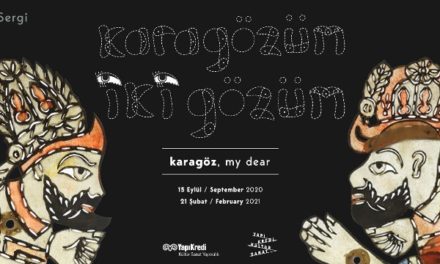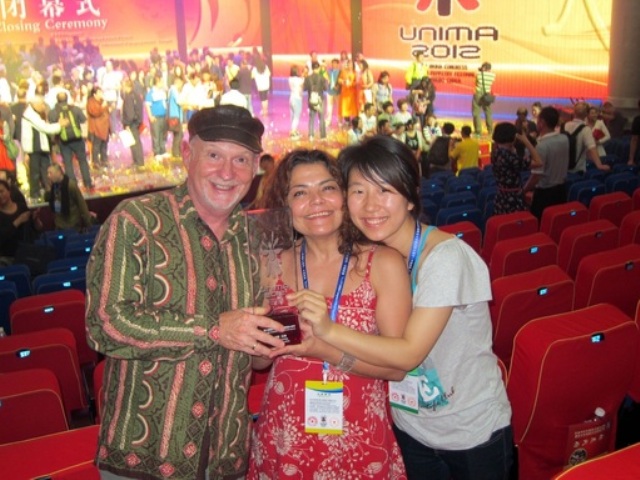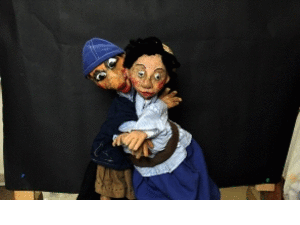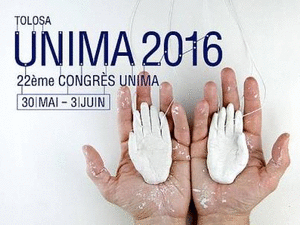(Image of the stage at the Palace of Carlos V before the performance. Photo T.R.)
Granada recently experienced unprecedented enthusiasm for a musical-puppetry event with the celebration of the centenary of the opera El Retablo de Maese Pedro by Manuel de Falla – premiered in Paris in 1923 – with a performance of the revival, directed by Enrique Lanz of Títeres Etcétera, at the Palace of Carlos V in the Alhambra.
Furthermore, four exhibitions were held that were directly and indirectly related to the anniversary and to the shared endeavour of the original three artists and friends, Manuel de Falla, Federico García Lorca and Hermenegildo Lanz; work that culminated in the renowned puppetry performance at the Lorca family house on Epiphany, 6th January 1923.
Titeresante went to Granada in order to report on these events and the performance of the opera in the Alhambra, during the 72nd Festival of Granada.
Granada, centre of an unusual cultural and creative crossroads
Rarely does such a concurrence of celebrations and opportunities occur as in Granada with the presentation of the version of Master Peter’s Puppet Theatre, with its giant puppets, of Manuel de Falla’s best known opera, El Retablo de Maese Pedro.
As is well known, the work was commissioned from Manuel de Falla in 1918 by the Princess of Polignac. From the beginning, it was clear to the composer from Cadiz that his opera would focus on the episode in Chapter XXVI of the second part of Don Quixote, which deals with the performance of Maese Pedro’s puppets. In 1919, Falla settled in Granada, where he became friends with Lorca and, through him, with Hermenegildo Lanz, a teacher and visual artist who had a deep interest in set design and puppetry. The three became passionate about shared projects, centred on puppets, and this fed into the writing of the opera.
Two episodes converged and awoke the enthusiasm of the three artistic conspirators: an evening’s entertainment they decided to hold of puppetry, poetry and music on Epiphany 1923 at the Lorca family house, with the celebration of the feast of the Three Kings as an excuse; and Falla’s decision that the premiere of his opera in Paris should be performed with puppets and set design by Hermenegildo Lanz.
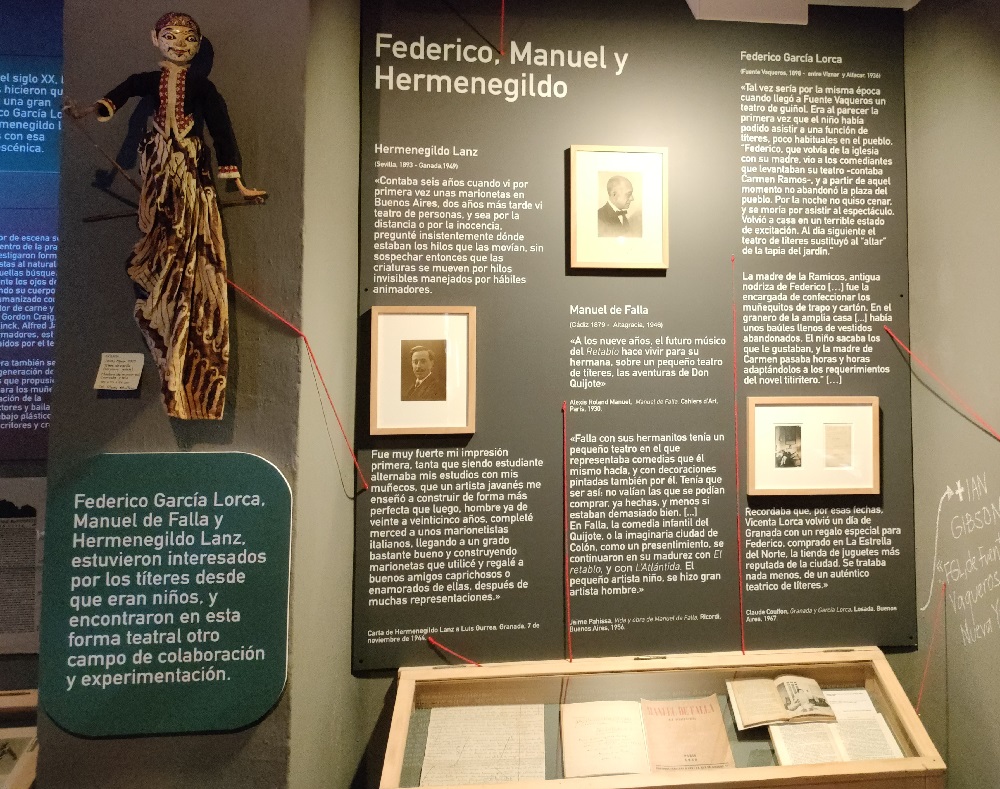
Image of the exhibition ‘Trabajos Cachiporrísticos. Títeres de Cachiporra y el Retablo de Maese Pedro. 1923-2023″, by Enrique Lanz and Yanisbel V. Martínez at Sala Granero del Museo Casa Natal FGL, Fuente Vaqueros. Photo T.R.
These are two key episodes in the history of Granada and Spanish culture, to the delight of musicians, artists, poets and puppeteers. Episodes little known to the public, but of monumental importance given their consequences, and because it marked the future course of the three artists concerned. A future full of promise, cut short by the Civil War.
Precisely, the four exhibitions shown in Granada (at the Federico García Lorca Centre, at Lorca’s birthplace in Fuente Vaqueros, at the Huerta de San Vicente where the poet’s family summer home is located, and at the Casa de los Tiros, in the centre of the city), deal with these episodes, each from a different and complementary perspective.
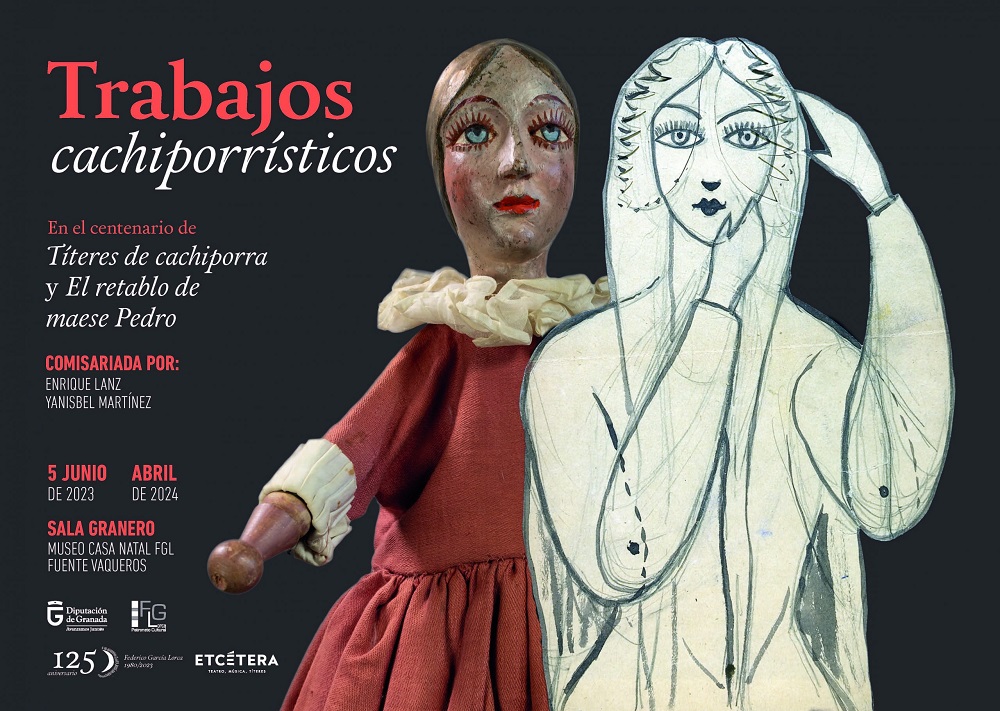
Poster of the exhibition in Fuente Vaqueros
It is now time to focus on the central event of this centenary, the performance of Falla’s opera at the Palace of Carlos V in the Alhambra.
A singular, paradoxical and exquisite space.
What can we say about the Palace of Carlos V in the Alhambra in Granada that has not been said before and that the reader cannot find in books on history of art and architecture?
Little, no doubt, but even so, our puppeteering boldness impels us to see in this building the daring of a ruler radically captivated by the period’s Renaissance ideals, eager to leave his mark on history while acknowledging the greatness of what had been conquered from the Moors some years earlier. A construction that reminds us of that other bold gesture in Cordoba, building in the middle of its acclaimed mosque a Gothic-Renaissance church, utterly unashamed but with the intelligence to respect the magical Moorish colonnade that surrounds it.
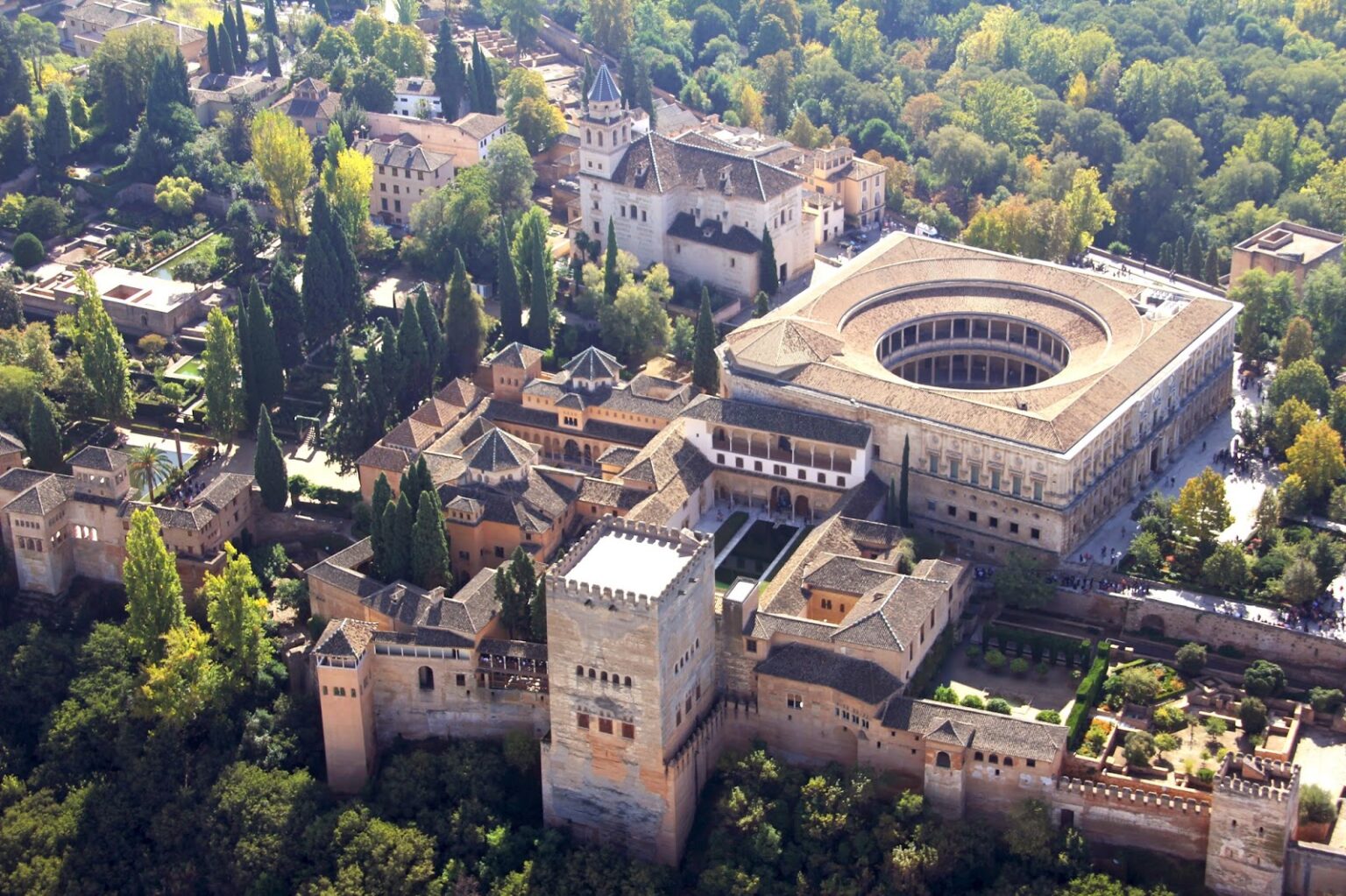
Aerial view of the Palace of Charles V in the Alhambra. Source, blog Patrimonio Cultural y Artístico de Andalucía.
The Palace of Carlos V appears to us today as a magnificent Renaissance behemoth, a weighty stone mass of Italian elegance in monumental contrast to the poetic and geometric subtleties of the gardens of the palace of the last Nasrid king of Granada, Muhammad XII, better known as Boabdil the Younger. Something similar to the forceful military intelligence of Gonzalo Fernández de Córdoba y Enríquez de Aguilar, better known as the Great Captain (and buried precisely in Granada, in the spectacular church of the Monastery of San Jeronimo), who fought in decisive wars against the Moors in the last years of the Reconquest, but who personally escorted his prisoner Boabdil into exile in Fez in 1494, as a sign of the respect and friendship that united them.
These were contrasts of an era that knew how to combine military might with respect and the intelligent vision of the Renaissance, its taste for beauty, subtlety and difference, something that would soon disappear as the Church took over the Peninsula and then what would soon become the Spanish Empire, with its inquisitorial intransigence and continued shameful expulsions of Moors and Jews.
The Palace of Carlos V speaks of this complex and contradictory period, simultaneously so rich and dramatic, amidst the magnificent setting of what was the last Nasrid palace in Granada.
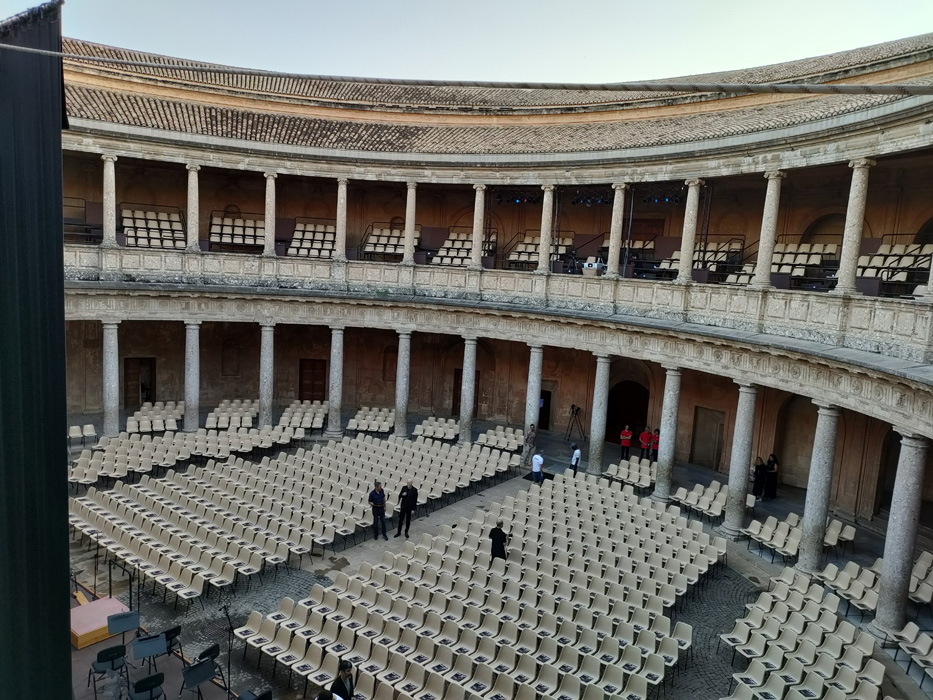
The Palace of Carlos V before the performance. Photo T.R.
This is an ideal setting to perform an opera such as Falla’s, where Cervantes puts an episode set in the wars between Moors and Christians into the mouth of an itinerant puppeteer of his time. Here, the bellicose demand of Charlemagne is imposed on the refined King Marsilio of Zaragoza by the hand of Don Gayferos, the blasé husband of the beautiful Melisendra, a captive in the tower of the castle, now called Aljafería; Melisendra is eventually rescued by the Christian knight.
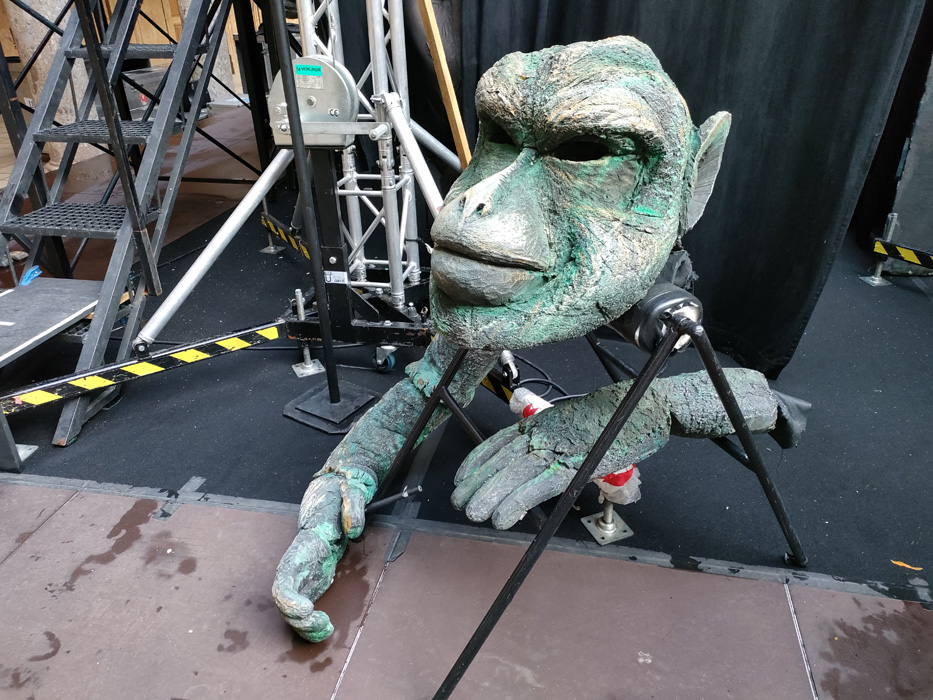
The monkey puppet. Photo T.R.
Does not Cervantes’ respectful, intelligent, ironic and distant gaze resonate among the stones of the Palace of Carlos V, the fruit of Hispanic madness that rises impudently amidst the subtleties of an era that resolved its contradictions on the battlefields? An old-fashioned serenity, self-confident, eager to square the circle of a great power, framed by the rationality of the square in Renaissance garb. At the centre of the circle, Cervantes’ fierce yet compassionate, contradictory and puppet-like mockery, seen from Falla’s cultured and profoundly quixotic viewpoint. A true luxury.
The Etcetera Puppet Theatre
I was already familiar with Enrique Lanz’s version of El Retablo de Maese Pedro, which can be translated either as Master Peter’s Puppet Theatre or Master Peter’s Puppet Show, from when it premiered at the Liceu in Barcelona; a work that, even then, amazed me for the audacity of Etcétera Theatre’s monumental puppets, created to perform on the enormous stages of opera houses. Puppets that require several animators and whose strings are ropes moved from below with the use of pulleys and counterweights. How to control their movements given such difficult technical conditions? Lanz manages it through his enormous skill and inventiveness, and of course by simplifying these movements to essential gestures, with oscillations of the face, mouth, eyes and hands, and so on.
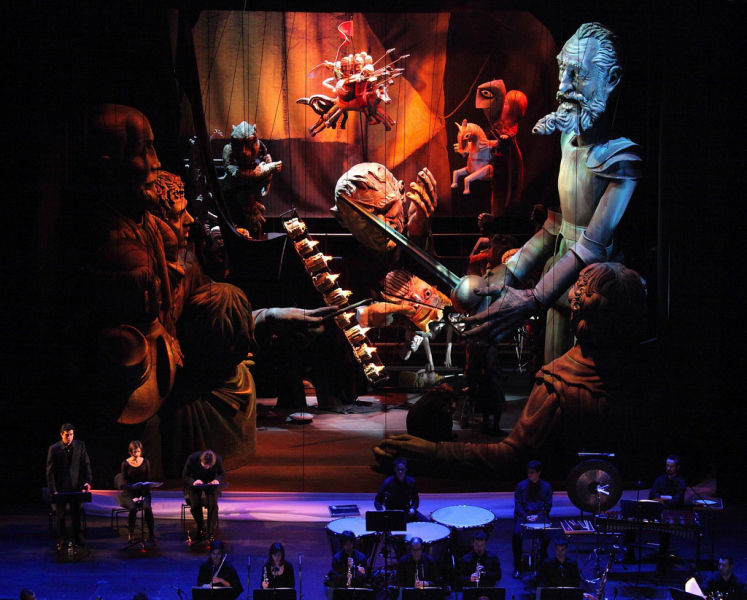
Image of the Retablo de Maese Pedro, photo Etcetera theatre company.
But what is really striking is to see in these dimensions the hieratic nature of the puppets’ faces, the basis of all puppet theatre, with their elegant and stylised movements. Faces, some with their backs turned and others facing forward, that, except for Trujaman who explains the story and the puppeteer Maese Pedro who intervenes from time to time from inside his little puppet booth, remain for a good part of the work as extras in a static, although mobile frame – since they never stop moving – to be activated at the end with Don Quixote’s outburst.
Enrique Lanz sought a style for these giant puppets – Don Quixote measures 8.5 metres only from the knees, and Trujaman 6 metres – that was both distant and bronze-like, of figures marked by the historical time of a novel that is well known to the public.
Meanwhile, the story narrated by the boy assistant, Trujaman, takes place in Maese Pedro’s little theatre, small compared to the monumental set of his audience, but not in its actual dimensions, because the smallest puppet is 1.5 metres tall and the biggest, the character of Charlemagne, 5 metres!
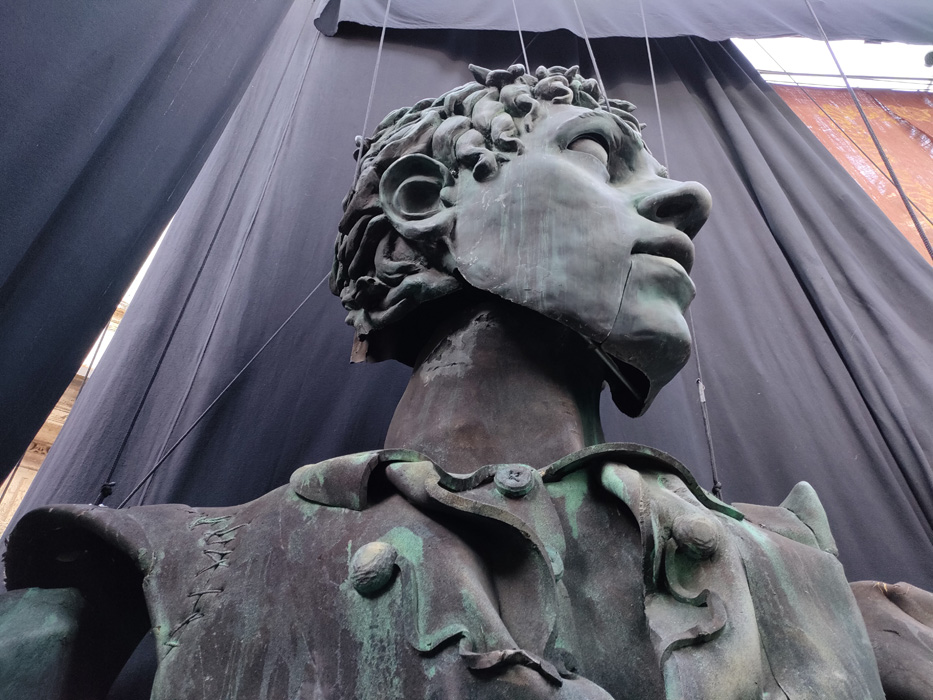
Close-up of the Trujaman puppet. Photo T.R.
For these puppets, made of rods and with other singular techniques and moved on rails and with springs, Enrique Lanz has chosen a very different style, in order to mark clearly the role they play, opting for colour and for a schematisation that some, such as Yanisbel V. Martinez, have defined as Picasso-like, but in reality are inspired by Romanesque art, Art Brut and the primitive geometry of the African world, which Etcetera knows well, having traveled to Mali where they connected with, and filmed the most important masters of these latitudes.
In this way they maintain a respectful but distant fidelity to the dramaturgy chosen by Hermenegildo Lanz for the premiere in Paris and later in Seville, which differentiated the puppets of the Cervantine audience, with Don Quixote and Sancho Panza as the main audience members, and those of the puppet theatre of Maese Pedro: in Paris the former were glove puppets and the latter were represented by the flat figures that he invented and that were so popular at the time, and, for the Seville premiere, with bigger puppets supported on top of the manipulators, and those of the puppet theatre using flat figures again, although larger.
Enrique Lanz’s homage to his grandfather Hermenegildo Lanz
And we must also understand this show created by Etcétera as an obligatory tribute to the person who directly and indirectly marked the professional and vital course of Enrique, his grandfather Hermenegildo, always seen by the grandson as a reference and foundational figure.
An operation that, however, goes beyond a homage, because the puppeteer from Etcétera, putting himself in his grandfather’s shoes, surpassed all the limits that usually limit professions such as puppetry, and dared to ascend the impossible with a bold, unprecedented affirmation of puppetry, leaping on to the big stages of opera houses that became the only possible, and most suitable places for his huge puppets to perform.
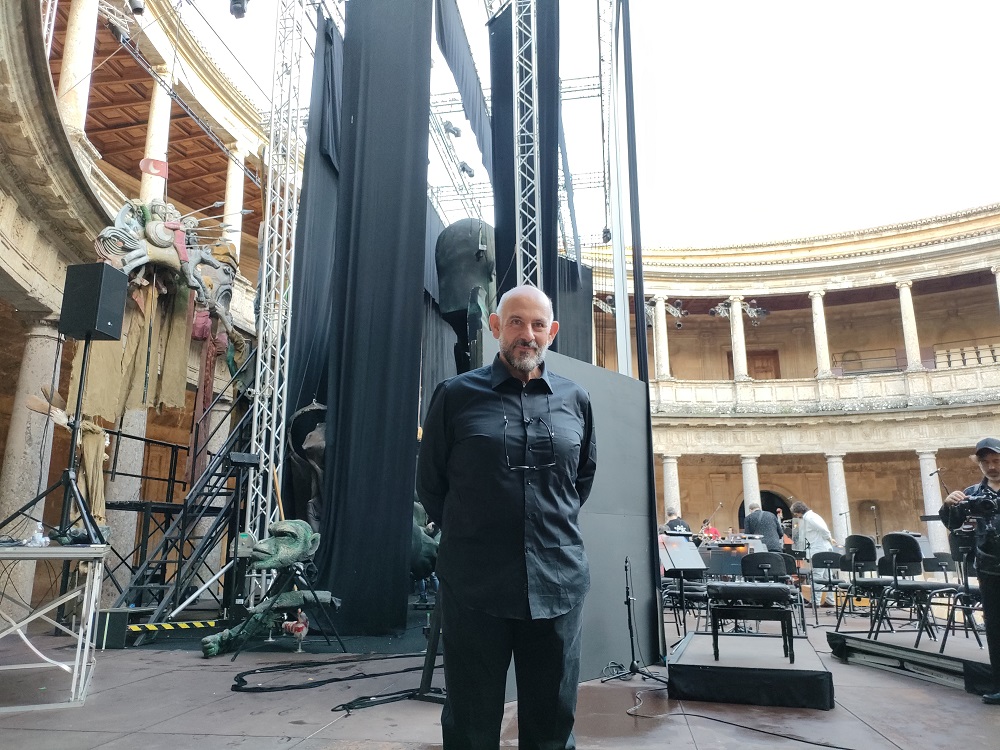
Enrique Lanz before the premiere. Photo T.R.
And Lanz does it with a restrained dramaturgy, allowing the music, with the orchestra placed in front of the puppets, to deploy all its enormous sonorous power, having first established the visual imaginary and where to pose and inhabit it. A sculptural art measured to the smallest detail, creating images that will last into the future, associated with Manuel de Falla’s most important opera.
A tremendous accomplishment that establishes Enrique Lanz as one of the great puppeteer artists of his time, capable of facing the most serious challenges and daring to undertake the most dangerous of ‘ocean crossings’ with his characteristic humility.
The performance at the Palace of Carlos V. Cast
For those who are not used to seeing shows and concerts in a space like the Palace of Carlos V, it is startling and surprising to see how the circular courtyard of a civil building can suddenly become somewhere that is more than suitable for the production of a communal show like an opera. One thinks of a bullring, or a sacrificial enclosure such as the coliseums or theatres of Ancient Rome. Ideal for ceremonies requiring centuries-old stones and structures suitable for rituals.
On this occasion, the musical rite was conducted by maestro Aarón Zapico, with the Granada City Orchestra. Alberto Rodríguez provided the lighting that was essential to allow the music and puppets to take us where they wanted. And as mentioned above, Enrique Lanz, from the company Títeres Etcétera, was the stage director, as well as the puppet builder, set designer and creator of the projections.
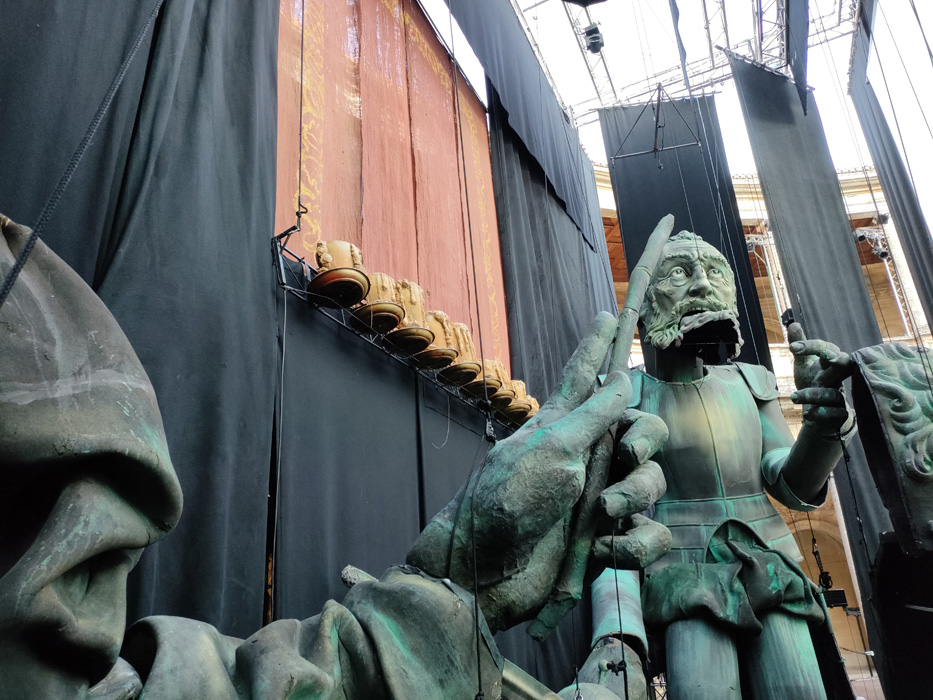
Backstage with the puppets. Photo T.R.
Soprano Alicia Amo provided the voice of Trujamán, often performed by a boy; baritone David Alegret played Maese Pedro; and baritone José Antonio López performed Don Quixote. Juan Carlos Garvayo was the harpsichord player.
The puppeteers were: Cristina Colmenero, Alejandro Conesa, Julien Flotat, Silvio Garabello, Christine Mackenzie, Irene Molina, Leo Lanz, David Rodríguez, Tete Rojas, Miguel Rubio, Adrián Zamora. Assistants: Begoña Molina, Luna Navajas, Alicia Cegrí and María del Carmen Padilla. All of them impeccable in their mission to bring the puppets to life.
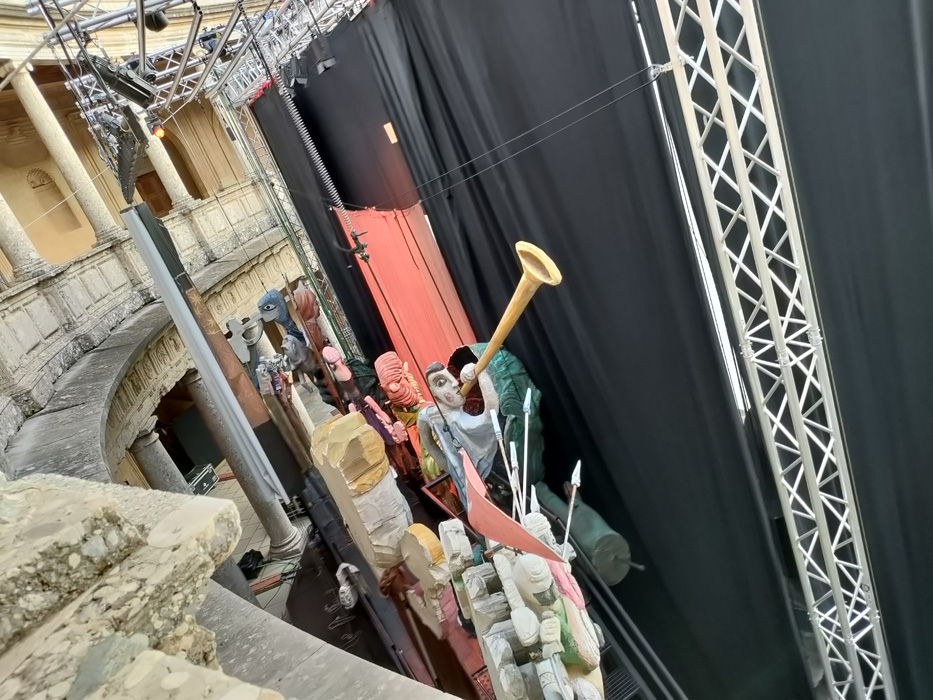
Behind the scenes. Photo T.R.
I must add that I loved the two pieces chosen for the introduction by the musical director; beautiful baroque works that created a veritable Cervantes antechamber for the episode of the Retablo: Burlesque de Quichotte, an overture-suite in G major from 1716 by Georg Philipp Telemann (1681-1767) and Don Quichotte chez la Duchesse from 1743 by Joseph Bodin Boismortier (1689-1755).
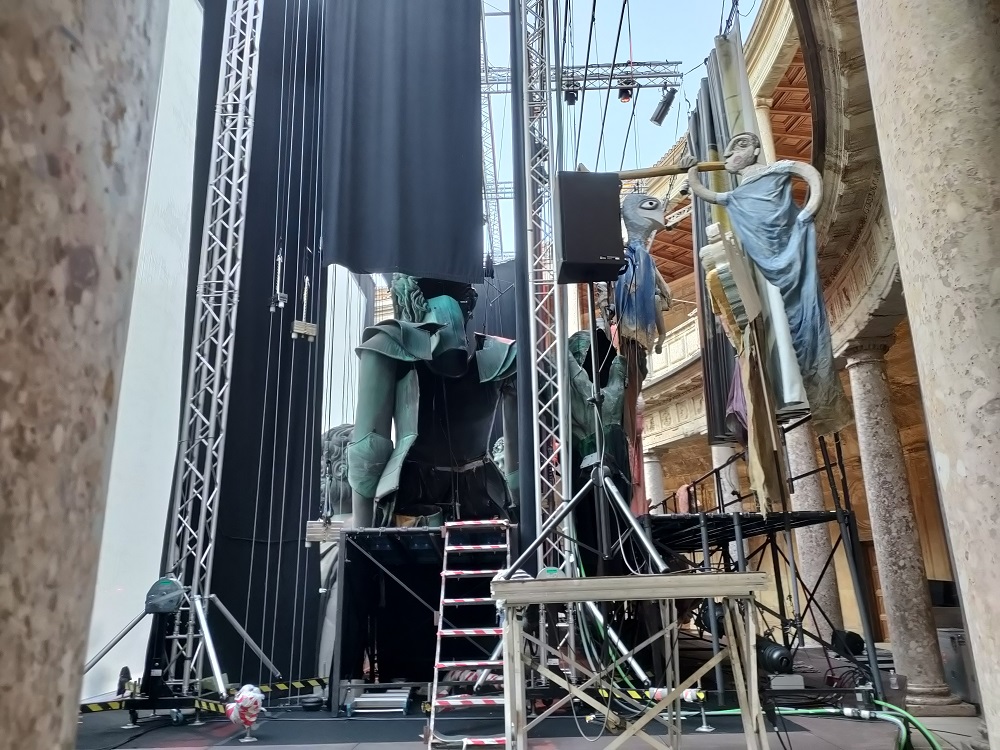
Behind the scenes. Photo T.R.


